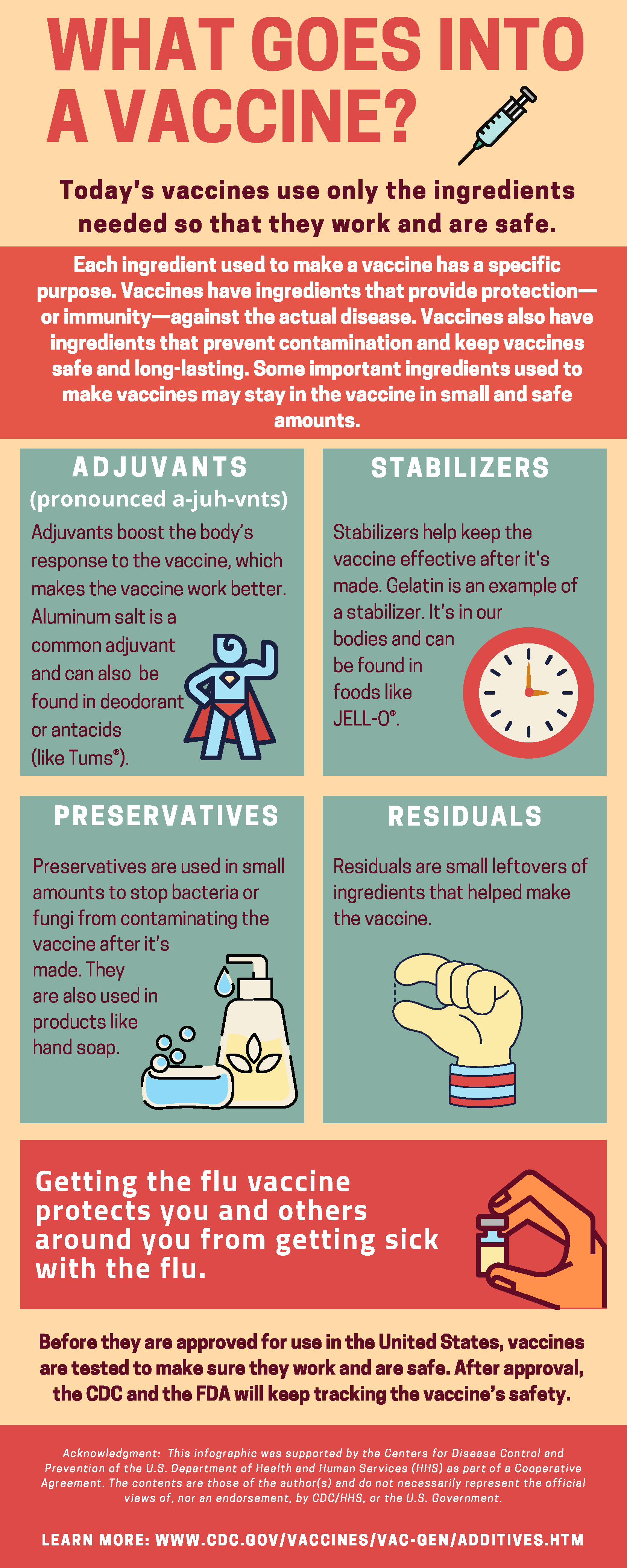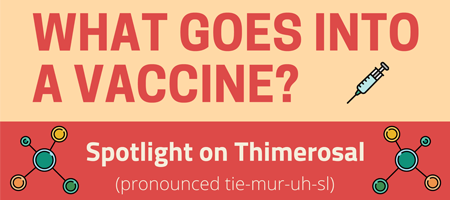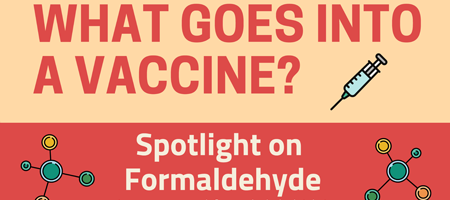
iREACH SMEs have developed a talking points document that addresses what we know about aluminum adjuvants in vaccines. The document provides information on ingredients that are commonly used in vaccines, including aluminum, and explains how to interpret information from scientific studies and what makes a study reliable/trustworthy. It also addresses whether vaccines cause long-term health problems and contains the important take-home message that the benefits of vaccines far outweigh their risks.
What ingredients are in vaccines?
Vaccines protect us against specific diseases. For example, the whooping cough vaccine protects us from whooping cough. Vaccines include ingredients to help them do their work. Each ingredient used to make a vaccine has a specific purpose. Certain ingredients, just like preservatives in foods, help keep vaccines safe from contamination and toxins that could make us sick. Preservatives also allow vaccines to stay on the shelf longer before they expire. Other ingredients in vaccines, like stabilizers, help vaccines stay effective for a long time. Here are some ingredients found in vaccines:
- Adjuvants: Adjuvants help boost the body’s response to a vaccine, which makes the vaccine work better. Aluminum salt is a common adjuvant used to help make a vaccine as effective as possible. It can also be found in drinking water, infant formula, antacids (like Tums®), buffered aspirin, and antiperspirant.
- Stabilizers: Stabilizers help keep a vaccine effective after it is made. Gelatin is an example of a stabilizer. These can be found naturally in our bodies and foods like Jell-O®.
- Preservatives: Preservatives are used in small amounts to stop bacteria or fungi from contaminating the vaccine after it is made. They are also used in products like hand soap and can be found in many of the foods we eat.
- Residuals: Residuals are small leftovers of ingredients that helped make the vaccine.
Related Resources
Infographic: What Goes Into a Vaccine?
Infographic: What Goes Into a Vaccine? Thimerosal Spotlight
Infographic: What Goes Into a Vaccine? Formaldehyde Spotlight
CDC Vaccine Ingredients page (English and Spanish)
FDA Common Ingredients in U.S. Licensed Vaccines
FDA Vaccines Licensed for Use in the United States (where you can find package inserts
for each vaccine and their ingredients)
FDA Study Reports Aluminum in Vaccines Poses Extremely Low Risk to Infants
What do we know about aluminum in vaccines?
- The aluminum salts in some U.S. licensed vaccines are aluminum hydroxide, aluminum phosphate, alum (potassium aluminum sulfate), or mixed aluminum salts.
- Aluminum adjuvants are used in vaccines such as hepatitis A, hepatitis B, diphtheria-tetanus-containing vaccines, Haemophilus influenzae type b, and pneumococcal vaccines. However, they are not used in live viral vaccines, such as those that prevent measles, mumps, rubella, varicella, and rotavirus. COVID-19 vaccines and influenza (flu) vaccines do not contain aluminum adjuvants.
- Vaccines containing aluminum adjuvants have been used for over 60 years in hundreds of millions of people around the world and found to be safe. Serious complications are very rare and the most commonly reported side effects are redness and swelling at the injection site.
- A study conducted by FDA determined that the risk to infants from the total aluminum exposure received from the entire recommended series of childhood vaccines over the first year of life is extremely low. This study provided additional scientific information confirming that the benefits of aluminum-containing vaccines administered during the first year of life outweigh any theoretical concerns about the potential effect of aluminum on infants.
- Of note, the most common source of exposure to aluminum is from eating food or drinking water.
Related Resources
FDA Common Ingredients in U.S. Licensed Vaccines
FDA Vaccines Licensed for Use in the United States (where you can find package inserts
for each vaccine and their ingredients)
FDA Study Reports Aluminum in Vaccines Poses Extremely Low Risk to Infants
CHOP Vaccine Ingredients – Aluminum
CHOP Q&A Aluminum in Vaccines: What you should know (English and Spanish)
CHOP Is the aluminum in vaccines safe? (video)
CHOP Is there a difference between aluminum that is injected vs ingested? (video)
Review article Aluminum and vaccines: Current state of knowledge (published Feb 2020)
How do we interpret information from scientific studies? What makes a study more reliable or trustworthy?
- When researchers try to determine if one thing led to another, for example, “did smoking lead to lung cancer?”they can study this possible association in different ways. Sometimes, they look back at everyone who has the disease (in this example,
lung cancer), to see if they smoked in the past, and compare that group of people to people who never smoked. They then look at whether more people who had lung cancer smoked versus people who did not smoke. - Other times scientists follow people who currently smoke and others who do not smoke, and after several years of following them, they see if more people who smoke have developed lung cancer.
- Scientists also look at other factors that could have led to lung cancer, such as exposure to cancer-causing agents at work, genetic (hereditary) factors, etc. Just because something occurs (event B) after something else (event A) does not always
mean that event A caused event B. For example, data shows ice cream consumption is linked to shark attacks—when one goes up, so does the other. But that doesn’t mean eating ice cream causes shark attacks or that those attacked by sharks are more likely to eat ice cream. Instead, both things are impacted by another factor—the weather. In warm weather, ice cream consumption goes up and more people visit beaches and have the chance of being attacked by sharks. - One of the best ways to determine if a research study is reliable is to see if it has been peer-reviewed. Peer review is when other scientists with expertise in the same area evaluate the research to ensure it is sound and reliable. This way, standards are kept.
- Another way to tell whether a study is trustworthy is if someone else conducted the same experiment under the same conditions and got similar results.
- The type of research study is also important. The gold standard of medical studies is called a randomized controlled trial (RCT). Another type of study is an observational study; however, observational studies are not as reliable and need to be repeated to make sure the conclusions are correct. Other things to consider are if there were any conflicts of interest and if there a possible motive behind those conducting the study. For example, did a drug company pay for a study that shows its drug cured cancer, or was the study conducted by a hospital using funding from an independent foundation?
Do vaccines cause long term health problems?
Vaccines are rigorously tested and continuously monitored for safety, and they have been used to prevent serious (and sometimes deadly) diseases for more than 200 years. While nothing is completely without risk, the benefits of vaccines far outweigh their risks. Many scientific studies have been conducted to ensure vaccines are safe in the long-term. While studies sometimes show that a health condition appears around the same time that people get one or more vaccines, there has been little evidence to suggest that those conditions arise because of vaccines.
In September 2022, a study was published that points to an association between the total amount of aluminum children receive from vaccines prior to 2 years of age and the increased likelihood of these children having persistent asthma between ages 2 to 5 years. This study used data from the Vaccine Safety Datalink (VSD), which obtains electronic health record data from a large network of health care systems. This study, along with other studies published by the VSD since 2016, investigate associations between the childhood immunization schedule and specific health outcomes.
CDC agrees with the authors of the study that this single observational study does not show that aluminum in some childhood vaccines causes the development of persistent asthma. Multiple factors, such as exposure to mold allergens, secondhand smoke, etc., have all been linked to the development of asthma. However, these factors were not investigated in this study.
CDC, FDA, and the National Institutes of Health recommend further study to investigate the potential risk of aluminum exposure from routine childhood vaccines. Multiple studies to investigate whether these findings are consistent and found repeatedly (reproducible) are needed.
The fact that this was a CDC-funded study shows that CDC takes vaccine safety seriously and is committed to sharing scientific findings about vaccine safety in a timely and transparent matter.
At this time, CDC does not plan to make any changes to the routine childhood vaccination schedule. CDC continues to recommend that parents and caregivers follow the routine childhood vaccine schedule to ensure that children receive their vaccines in a timely manner to protect them against serious and sometimes deadly diseases.
I am a parent of a 2-year-old. Should I stop vaccinating because of this study?
No, you should not stop vaccinating. Here is why:
Vaccines containing aluminum have been used to prevent serious diseases for over 60 years. Hundreds of millions of infants, children, and adults have received aluminum containing vaccines worldwide. Aluminum is used in vaccines as an adjuvant, a substance that makes the vaccine work better to boost the immune response to some vaccines.
We ingest more aluminum from our foods and drinks every day than we get from vaccines. While very high levels of aluminum can cause serious harm to the body. the amount of aluminum in vaccines is very small. When we take aluminum products into our bodies, only small amounts are absorbed into our bloodstream. Our bodies get rid of aluminum very quickly, primarily through our kidneys. Vaccines containing aluminum are all tested in humans before being licensed and are regulated by the Center for Biologics Evaluation and Research (CBER).
What’s the take home message?
The most important thing to know about vaccines is that their use in preventing dangerous diseases strongly outweighs their risks. Vaccines are continuously monitored for safety so that even seemingly minor concerns related to vaccine safety are noticed and carefully examined. Research, such as the study recently published about asthma and aluminum adjuvants, is important as scientists are constantly evaluating vaccines to make
sure they are as safe as possible while they protect us from disease.
Sources
- Aluminum Effects in Infants and Children (AAP website)
- Addressing Parents’ Concerns: Do Vaccines Contain Harmful Preservatives, Adjuvants, Additives, or Residuals? (AAP website)
- Adjuvants and Vaccines (CDC website)
- Common Ingredients in U.S. Licensed Vaccines (FDA website)
- Updated aluminum pharmacokinetics following infant exposures through diet and vaccination.
Vaccine 29 (2011) 9538-9543
doi.org/10.1016/j.vaccine.2011.09.124 - Aluminum Content in Infant Formulas, BMC Pediatrics 2013 (NIH website)
- CDC/ATSDR: Aluminum:
https://wwwn.cdc.gov/TSP/substances/ToxSubstance.aspx?toxid=34 and
https://wwwn.cdc.gov/TSP/ToxFAQs/ToxFAQsDetails.aspx?faqid=190&toxid=34 - Agency for Toxic Substances and Disease Registry
Toxicological Profile for Aluminum (PDF)
Atlanta, GA, 2008
This resource is supported by the Centers for Disease Control and Prevention of the U.S. Department of Health and Human Services (HHS) as part of a Cooperative Agreement. The contents are those of the author(s) and do not necessarily represent the official views of, nor an endorsement, by CDC/HHS, or the U.S. Government.



